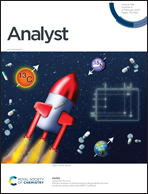Ratiometric fluorescent semiconducting polymer dots for temperature sensing†
Abstract
Semiconducting polymer dots (Pdots) have received much attention due to their unique characteristics, including high water solubility, good light stability, excellent biocompatibility, and low cost. Herein, we report a ratiometric nanoprobe based on Pdots-Eu for temperature sensing in vitro. The Pdots-Eu thermometer was composed of a blue temperature-insensitive semiconducting polymer, poly(9-vinylcarbazole) (PVK), a red temperature-sensitive complex tris(dibenzoylmethane)mono(5-amino-1,10-phenanthroline)europium (III) (Eu complex), and an amphiphilic polymer polystyrene graft ethylene oxide functionalized with carboxyl groups (PS-PEG-COOH). The Pdots-Eu thermometer showed two peaks at 368 nm from PVK and 611 nm from the Eu complex. The red/blue fluorescence intensity ratio of Pdots-Eu decreased with an increase in temperature, which could be used for the ratiometric monitoring of temperature change. The results showed that the red/blue fluorescence intensity ratio demonstrated a good linear relationship to the change of temperature from 25 °C to 55 °C. Impressively, the ratiometric probe featured good accuracy and high sensitivity for temperature detection in vitro, which could be used for monitoring temperature change in cells.



 Please wait while we load your content...
Please wait while we load your content...